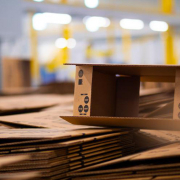The International Corrugated Packaging Market Is Still Growing
According to market intelligence, testing and consulting firm Smithers, the latest data for the global containerboard and corrugated packaging market would show that consumption of the latter reached 160.5 million tons in 2020; the value corresponded to 170.7 billion US-Dollar. Expert analysis in the Smithers report “The Future of Global Corrugated Board Packaging to 2025” forecasts that the global corrugated board will increase at a compound annual growth rate (CAGR) of 3.8 percent across 2020-2025 to reach 205.7 billion US-Dollar. “The volume of board consumed worldwide will increase at a slightly slower rate to reach 193.2 million tons in that year,” the information said.
As predicted, the Covid-19 pandemic will see a marked impact on corrugated consumption in certain sectors and regions, especially those worst affected by the virus. In terms of end-uses, food shipments would be the least affected while other consumer items will see a more significant drop, the company emphasized. “These will be mitigated in developed regions by the strong increase in e-commerce as stay-at-home consumers undertake more online shopping. Several board converters have developed e-commerce specific delivery designs to capitalize on this, accentuating what the industry has already identified as a key growth segment.”
Recycling, sustainability and price pressure
In the longer term, Smithers analysis identifies the following business trends that will support further use of corrugated board packaging:
- Recycling and sustainability will remain a key concern for converters and brand owners, but an oversupply of materials is liable to generate new price pressures
- Demand for finer flute grades for high-quality printed cases and as alternatives to folding cartons will rise
- Further pressure for light-weighting of corrugated designs will have a negative impact on volume sales as less fiber delivers an equivalent required performance
- E-commerce will continue to expand, even once lockdown (shelter-in-place) orders have been revoked; this will generate a new need for white-top liner that can receive high-quality print graphics in particular
- Dimensional (DIM) weighing in packaging and the focus on minimizing extraneous protective components will slow some of the expanded use of corrugated in direct-to-consumer e-commerce shipping
- There will be more use of retail-ready packaging formats, as more modern retailing expands into developing markets in Asia and elsewhere
- Digital (inkjet) printing will increase the overall demand for better quality substrates and expand the options for packaging printers
- New coating technologies, including bio-based polymer solutions, will help improve the recyclability of coated corrugated grades
- Industry consolidation will continue leading to a greater concentration of capacities and more uniformity for users.
“These trends and the essential technologies that will help make them a reality over the next five years are examined in depth in the Smithers study,” the company noted. “They are used to provide context to the wider picture of the industry across 2015-2025 given in the Smithers data set, with over 350 data tables and figures.”
(Published in GLOBAL RECYCLING Magazine 2/2021, Page 13, Photo: O. Kürth)







